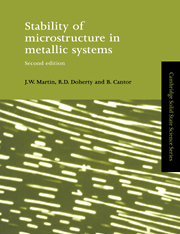Book contents
- Frontmatter
- Contents
- Preface to first edition
- Preface to second edition
- Chapter 1 The general problem of the stability of microstructure
- Chapter 2 Structural instability due to chemical free energy
- Chapter 3 Highly metastable alloys
- Chapter 4 Instability due to strain energy
- Chapter 5 Microstructural instability due to interfaces
- Chapter 6 Other causes of microstructural instability
- References
- Index
Chapter 3 - Highly metastable alloys
Published online by Cambridge University Press: 18 December 2009
- Frontmatter
- Contents
- Preface to first edition
- Preface to second edition
- Chapter 1 The general problem of the stability of microstructure
- Chapter 2 Structural instability due to chemical free energy
- Chapter 3 Highly metastable alloys
- Chapter 4 Instability due to strain energy
- Chapter 5 Microstructural instability due to interfaces
- Chapter 6 Other causes of microstructural instability
- References
- Index
Summary
Almost all metallurgical materials are metastable in one way or another. Manipulating the metastability in alloy microstructures has proved to be essential in order to obtain the wide range of properties needed for different kinds of manufactured component. The conventional metallurgical processing methods of casting, deformation and heat treatment are used to control microstructural features such as chemical homogeneity, grain size, extent of precipitation and dislocation substructure. These are associated with relatively slight deviations from equilibrium, and are discussed in the other chapters of this book. In recent years a variety of processing methods have been developed to manufacture alloys with highly metastable microstructures, that is, with greater deviations from equilibrium. These highly metastable alloys are the subject of the present chapter.
The different methods of manufacturing highly metastable alloys all depend upon manoeuvring the material into a condition far from equilibrium, and simultaneously removing its thermal energy to freeze it into a metastable state. The microstructures that can then develop depend upon both thermodynamic and kinetic factors. Thermodynamic conditions define a set of possible alloy microstructures with lower free energy than the starting state. Kinetic behaviour determines which of these microstructures actually develops during manufacture. The main kinds of metastable material that can be manufactured are microcrystalline and nanocrystalline alloys with ultra-fine grain sizes, segregation-free highly supersaturated solid solutions, new metastable crystalline alloy compounds, amorphous alloys with non-crystalline disordered atomic structures, and quasi-crystalline alloys with ordered but non-periodic atomic structures.
- Type
- Chapter
- Information
- Stability of Microstructure in Metallic Systems , pp. 84 - 146Publisher: Cambridge University PressPrint publication year: 1997



